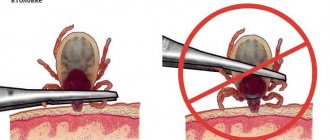How does tick infection occur?
Exogenous parasites can live on land, in water, and on other animals. Therefore, the danger of infection exists every day. Even if your pet does not go outside for walks, you should not think that the cat is safe. How can a tick get on an animal? It's simple. You walked through the grass or past bushes, through a forest park or walked along an alley, and a small hungry tick got on your clothes. This is how you bring it home - on yourself.
Hungry ticks (photo below), especially if the peak of their activity has arrived, are very nimble.
They are also very small and are not afraid of anything. And only fire will stop the ixodid tick altogether.
Some people mistakenly believe that there is nothing dangerous about ticks sitting on a cat. However, it is not.
Firstly, the parasite can be a carrier of dangerous diseases.
Secondly, ticks in cats can get into the ears and under the skin, making the process of finding them extremely difficult. We must not forget that ticks can “spread” from a cat to other pets and even to people (ear mites are not dangerous for humans, but they happily “spread” to healthy cats).
Folk remedies
In parallel with traditional ones, alternative methods of therapy are used. folk recipes against askariasis:
- Infusion of leather mackerel. 1 tablespoon of dry herb is poured into about 5 liters of boiling water and set aside until it cools completely. The strained solution is diluted with 0.5 liters of water and the pet is bathed. The plant has a bactericidal effect and promotes rapid healing of wounds.
- Wounds are treated with calendula tincture. To avoid side effects, it is better to buy the product at a pharmacy and use it according to the instructions.
- Treatment of wounds with concentrated chamomile infusion. To prepare it, 100 dry plants are poured with boiling water. The cooled infusion is filtered.
Be sure to read:
How many days before vaccination should a cat be given anthelmintic: why, how to do it correctly, the best remedies
It is forbidden to treat leather with kerosene. The substance causes severe intoxication.
Ear mites in cats
A pet can become infected with ear mites as a result of:
- communication with a sick animal;
- contact with contaminated objects, which may include dishes, hygiene items, and bed mats.
In addition, there is a high probability that ear mites could be brought into the house from the street by any family member. You can also “grab” a tick with you at the entrance, where stray infected cats often end up. Insects, parasites that often infect animals, also become carriers of ticks. A person need not be afraid of infection - contact with a sick cat is not dangerous for him.
Heyletiella
One of the names for cheyletiellosis is stray dandruff. A highly contagious disease caused by the cheyletella mite. It is dangerous for cats and dogs. You can even pick it up in grooming salons. A person can also be its carrier and the risk of infection cannot be excluded for him.
The disease received its original name due to the way the tick moves. The coat of an infected cat resembles a surface that is dotted with trails of raised hair with dandruff. Mites settle in the upper layers of the skin and feed on keratin scales, causing itching and irritation on the skin.
Since dandruff can be caused not only by mites, but also by many other diseases, a differential diagnosis is important.
Ear mites in cats - symptoms
Under the influence of the disease, the behavior and physical condition of the animal changes. The following signs indicate that a cat is infected with ear mites:
- The pet behaves restlessly, constantly “shaking” its head, meowing often, clinging to the owner, tilting its head to the side.
- To relieve the unbearable itching, the animal rubs its ears against the corners of furniture and various objects, often scratching them.
- After some time, a purulent mass may emerge from the auricle.
- The cat develops brown crusts inside and around the ear.
If untreated, tick symptoms in cats worsen, and the inflammation gradually affects the inner and middle ear, moving further to the meninges. This condition is indicated by such signs of ear mites in cats as:
- depressed state;
- increased body temperature;
- head curved towards the affected ear;
- seizures leading to the death of the animal.
You can prevent terrible consequences if, when the first symptoms of otodectosis appear in cats, you contact a veterinarian to prescribe treatment.
A cat has ear mites - treatment
Treatment of ear mites in cats cannot be undertaken without an accurate diagnosis, since symptoms similar to this infection are present in other diseases. The doctor will be able to check whether your suspicions regarding this disease are justified when he examines the animal’s ears using special instruments and, if necessary, conducts a microscopic examination of the ear discharge. After otodectosis is confirmed, the specialist will prescribe and carry out treatment procedures:
- First, the ears will be cleaned by rinsing with antiseptic agents.
- Then liquid medications are instilled using a syringe with a rubber tube (usually ear mite drops for cats, which, according to the instructions, are injected into both ears of the animal, even when only one is inflamed). In this case, it is necessary to adhere to the exact dosage of the drug, because it contains a strong poison, which in a large dose can aggravate the pet’s condition.
- After the treatment procedure, you should massage the base of the cat’s ear.
Ixodid ticks
These insects often live in forested areas: on trees and shrubs. But it is possible that ixodid ticks live on grass and ground. Even if the forest is far away, the tick may end up in a desert area. For example, the wind brought a leaf or blade of grass on which the parasite was sitting.
Once the tick attaches, your cat or you become the victim. The parasite firmly attaches to the skin and begins to burrow into the skin. His head is inside the tissues, and his body is outside. And when it starts sucking blood, it increases tenfold!
Even if there is no pathogen inside the tick, the harm to health is considerable. Firstly, the tick secretes a secretion at the site of the “bite” that causes severe inflammation and itching. The animal will begin to itch, worry, and may pick off the sucking parasite with its paw. The bloodsucker's jaws will remain closed inside the skin, so even if it is torn off, its head will remain in the animal. This often leads to suppuration, and sometimes sepsis occurs.
Scabies
Scabies in cats, or sarcoptic mange, is a dangerous disease. Its causative agent is the microscopic mite Sarcoptes scabiei, which is equally dangerous for people and animals. The parasite settles on the surface of the skin and feeds on sebum. Females lay eggs in the upper layers of the cat's epidermis, which causes ulcers and suppuration.
The main symptom is severe itching, which cannot be relieved with antipruritic drugs. Papules form on the surface of the skin - small blisters filled with reddish contents. Their localization is along the edges of the ears, on the chest and stomach, on the elbow bends of the cat.
These symptoms are accompanied by focal baldness and ulcers. Cats often develop an allergic reaction, so it will take longer to treat your pet.
Treatment for scabies, which is usually prescribed by a veterinarian, includes:
- bathing the cat using antiparasitic drugs once a week;
- injections;
- treating affected areas of the skin with ointments and drops;
- use of antibiotics – in case of threat of secondary infection;
- taking antihistamines and immunomodulators – if necessary.
Interesting! A person can easily become infected with scabies mites. But the parasite does not reproduce on human skin. If you protect yourself from re-infection, then after the life cycle of the pathogen is completed, scabies will disappear even without treatment.
How to properly remove a tick from a cat?
It is extremely important to properly remove a tick from a cat. Ideally, you need to arm yourself with special tweezers, because you can crush the reptile with tweezers.
Grab the tick at the neck and gently turn it counterclockwise until it opens its jaws and falls off. No oils, creams or hot needles in the torso! Yes, sometimes this leads to the parasite unclenching its jaws, but more often it, on the contrary, closes them even more tightly and then dies. And only then can it be removed surgically.
Do not pull, tear, tug, wrap with thread, handle with bare hands, or use tweezers.
There are many prohibitions, but in reality everything is not so complicated. If you suspect that you cannot cope on your own, then seek help from a veterinarian. He knows how to properly remove ticks (photo) from cats.
Don't throw away the ticks! They are very tenacious. Collect them in a glass bottle (for example, left over from penicillin or some other drugs, a jar of baby food will do).
Ideally, you should take the extracted parasite to the center of sanitation and epidemiology or to a veterinary laboratory so that it can be studied. If the causative agent of piroplasmosis is found in it (and this is also a parasite that “settles” in red blood cells, destroying them), then it is necessary to begin treatment of the cat affected by the tick as soon as possible. In addition to piroplasmosis, a tick can “give” your pet diseases such as theileriosis, tularemia or hemobartonellosis.
Subcutaneous mites in cats
The subcutaneous mite often affects dogs, but cats also suffer from this parasite. This reptile is called Demodex.
It is worth noting that a person can also become infected with demodicosis through contact with a sick animal! Alopecia, acne, and inflamed red areas appear on the skin. The cat itches, “cries”, worries. Therefore, it is necessary to be extremely careful in “communicating” with stray or “suspicious-looking” animals.
Try not to let your pet go for a walk alone, do not let him “get acquainted” with other animals so that your cat does not become infected.
The incubation period of demodicosis can last for years!
But as soon as the cat’s immunity weakens, this parasite will make itself felt. Most often, these mites (photo) in cats affect the areas around the eyes, ears, and neck. The hair falls out, severe itching begins, the skin turns red and becomes inflamed. It is very difficult to cure a cat from these mites.
In addition to demodicosis, notoedrosis may occur - this disease is caused by scabies mites, which are also localized under the skin. Of course, the symptoms will be similar to the clinical signs of scabies:
- itching;
- hair loss;
- anxiety.
You should be extremely careful, it is better to contact your veterinarian for help.
Possible consequences of a bite
There is a myth that an Ixodid tick bite is safe for a cat, but this is only a misconception. Ticks can carry dangerous diseases:
- Hemobartonellosis. In another way, it is called infectious anemia, caused by Bartonella (a type of microorganism).
- Borreliosis or Lyme disease. The waste products of the Borrelia pathogen cause a severe allergic reaction in the pet, muscle and heart pain, kidney and brain damage.
- Theileriosis. The cat's lungs, kidneys, heart, and liver suffer. This disease is difficult to treat.
During the time taken measures are ways to prevent difficult health situations in the future.
Piroplasmosis
This disease is an intracellular parasite that is transmitted by ticks. Oxygen starvation occurs and the mucous membranes are damaged. The body loses the ability to process hemoglobin. This is how direct bilirubin appears - a toxin that gradually poisons the entire body. The animal can die within 4 days after the bite.
Encephalitis
This is an inflammation of the animal's brain, as a result of which the central nervous system dies. Humans are also susceptible to this disease. For an animal, encephalitis is deadly. Ticks are carriers of encephalitis, including one that is dangerous to humans.
When you urgently need to see a veterinarian
You should contact your veterinarian as soon as you notice changes in your cat’s behavior or a deterioration in its health. Do not forget that after the tick has been removed, it must be sent for appropriate tests.
Treating cats for ticks at home
Many owners wonder how to treat a tick on a cat at home, but a competent veterinarian will answer that it is not the tick that needs to be treated, but the animal itself. The main thing is not to resort to self-medication and be patient. It is already clear that depending on the type of tick and other circumstances, the parasite can infect your cat. And it is obvious that it is impossible to treat such diseases at home. In the case of subcutaneous parasites, even specialized treatment of a cat for ticks can take more than one month or even a year. And follow safety precautions so as not to suffer from the parasite yourself.
Kinds
Most often, the animal is affected by a microorganism called demodex. It cannot be seen without a microscope. It is shaped like a worm.
Demodicosis occurs in two varieties:
- localized;
- generalized.
With a localized form, a certain part of the skin is affected. In the case of a generalized form, the entire body is affected.
In this situation, after treatment, the cat should undergo a sterilization procedure, since the microorganism can be transmitted to offspring.
Anti-tick drops for cats
Medicine in the form of drops is very common, as it is one of the safest and most affordable. It is used not only to combat infection, but also to prevent otodectosis.
The course of treatment begins with the use of an emulsion, the fundamental component of which is Fipronil, Fenthion or Permethrin. The product must be rubbed into the skin of the withers and make sure that the animal cannot lick it off until it is completely absorbed.
To treat ear mites in cats, the following brands of drops are usually used:
- Celandine (the active ingredients of the drug are Fipronil and Permethrin).
- Biafar (differs from other drops by the presence of a natural component based on margose, which destroys insects).
- Leopard (the main component is Permethrin) is low toxic for cats, which explains its popularity.
- Frontline (the active ingredient of the drug is Fipronil) is effective against ear mites and their carriers, fleas.
Drugs and medications
Localized forms with complications and generalized forms are treated comprehensively. Medicines are selected individually, taking into account concomitant diseases and the condition of the predator.
In case of infection with D. cati and D. gatoi, use the following treatment regimen:
- Amitraz 0.25%. The oil solution is applied to the affected areas once a day every 3 days. Course 4-6 weeks.
- Invec spray is applied to the affected areas. Treat 2-4 times with an interval of 3-5 days.
- Doramectin orally once a day at a dosage of 40-60 mg per kg of body weight. Therapy is carried out for no more than a month.
- Antiparasitic drugs for parenteral administration (s.c.): Dectomax, Baymek, Cydectin.
- Antibacterial drugs Betamox (active ingredient amoxicillin), Kanamycin (amikacin), Ciprovet drops (ciprofloxacin).
Since the fundamental ethological factor is weakened immunity, biogenic stimulants are prescribed: Gamavit, Baksin.
Anti-tick collar for cats
But not only drops have the same effect on ticks and fleas: the most popular is a special collar against parasites. And this is explained by its undeniable advantages:
- simplicity and ease of use;
- safety for the cat;
- efficiency of application.
A high-quality flea and tick collar for cats is the best choice for the treatment and prevention of otodecosis. When choosing a product, pay attention to its characteristics:
- A quality product is always sealed in a foil bag.
- The collar should be intended only for cats (also separately for kittens and for pregnant or lactating pets).
- The material should not contain: Permethrin, Amitraz and organic phosphates.
Prevention
There is no vaccination against ticks! The salvation will be the special collars described above, drops on the withers. Ideally, you should refrain from walking through the forested area during the period of greatest tick activity (April-June, August-October). If there are disadvantaged places in your city, then do not go near them.
Before letting your pet into the house, carefully comb out the entire skin with a fine comb, inspect the belly, chest, paws, and ears. If you have combed out ticks, do not leave them on your doorstep. Otherwise they will stick to someone. On shoes or clothes they will enter someone's home (and maybe yours again).
To prevent your pet from getting ticks, try to avoid contact with other animals. At the slightest suspicion of infection, contact your veterinarian. He will take skin scrapings from the affected areas (in the case of subcutaneous mites) or take a whole skin parasite for examination. Only after a final diagnosis has been made, treatment will be prescribed.
Animal risk group
Parasitic arachnids affect all predators, regardless of breed, sex, or age. A healthy pet with a strong immune system is not in danger. Under such conditions, the animal and arthropods are in an antagonistic relationship, where the cat’s body slows down the growth of parasitic microorganisms.
The following groups are susceptible to demodicosis:
- young individuals, especially those separated from their mother early;
- affected by leukemia and immunodeficiency viruses;
- with diagnosed immunosuppressive diseases (diabetes mellitus, toxoplasmosis);
- animals in the postoperative period;
- young offspring during the period of change of milk teeth to molars (4-6 months);
- exhausted after fasting;
- patients with rickets.
Stress caused by moving and frequent visits to the groomer negatively affects the health of the pet. The risk of ascariasis increases.











